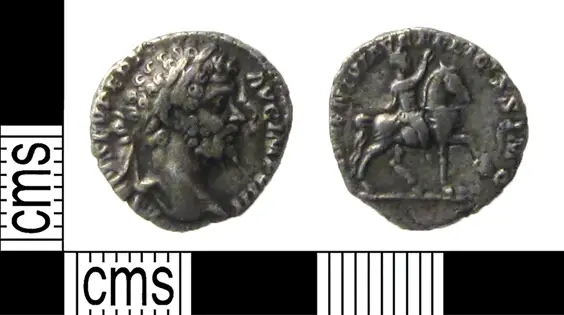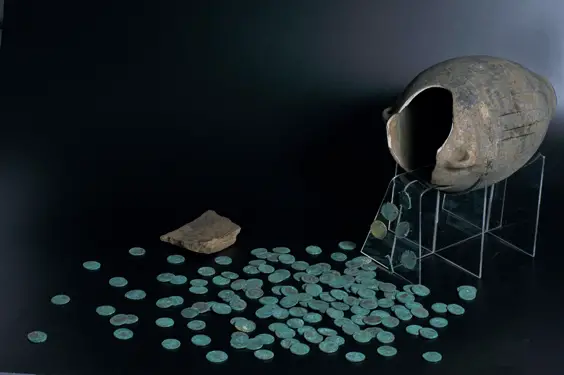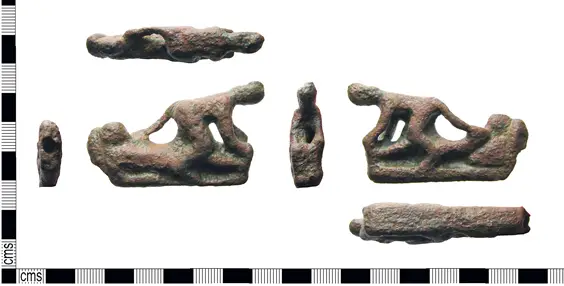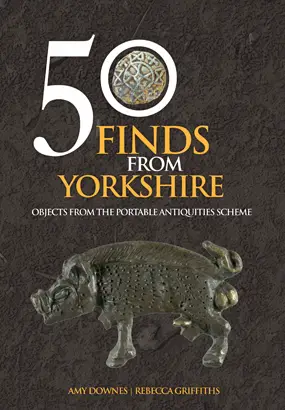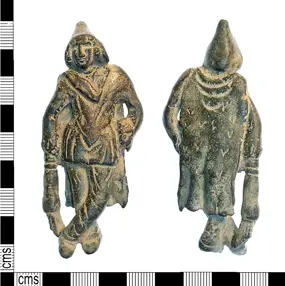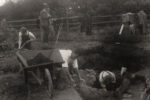Best Roman Finds From the Portable Antiquities Scheme in Yorkshire
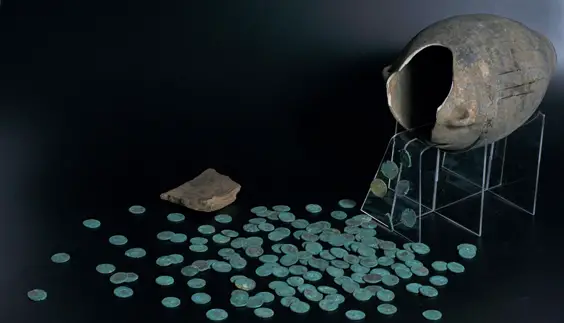
Highlighting the remarkable Roman objects found in the region
by Amy Downes and Rebecca Griffiths
Yorkshire was part of the Roman Empire for nearly 400 years, and it was during this period that the region began to establish itself as of central importance to Britain. When the Romans arrived in AD 48, what is now Yorkshire was occupied by two British groups: the Brigantes, who controlled most of the north, and the Parisii in the East Riding. It is generally assumed that the Roman occupation enforced changes upon the native population, but increasingly it is being seen as a period of mixing, adaptation and development, creating a distinctive Romano-British culture.
British objects generally did not show drastic shifts in design, but rather a gradual incorporation of new styles. More noticeable changes include the rise of civil engineering and the development of larger road networks, alongside the importing of pottery and coinage from the continent. The first Roman forts in Yorkshire were established at Templeborough and Rossington Bridge in the mid-first century AD, following expeditions from territory further south that was already under Roman rule. Previously, the Brigantian leader Cartimandua had supported the Romans but, when her tribe turned against her, the Romans felt it was time to stamp their authority on the area and the forts probably date from this time.
“Evidence of pottery making at various sites”
The Romans finally took permanent control of the north in AD 71, building the fortress at York and making Eboracum, as they called the city, their northern centre. The road system was extended and improved to join the network of forts with the fortress. Eboracum was ideally placed to allow easy transportation of troops and supplies from the North Sea along the Ouse. It was also accessible by land, sitting on a ridge that the Romans used as their main approach to the city. This route is still largely followed by the A64 today. In fact, many major modern routes follow roads established by the Romans.
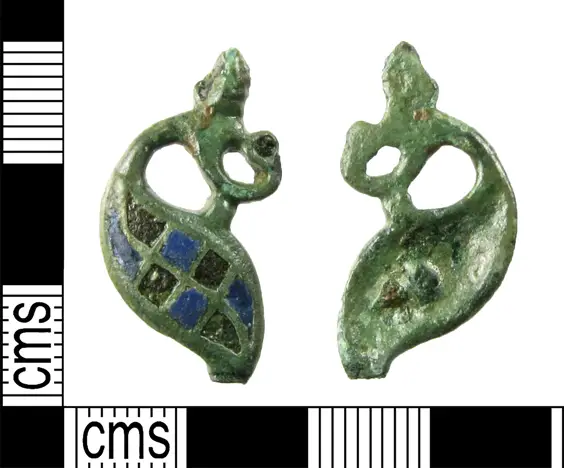
A copper-alloy dragonesque brooch from Burton Salmon, North Yorkshire, showing the continuation of Iron Age motifs on Roman artefacts (SWYOR-0E6FC5).
On sites unaffected by the Roman military, local manufacturing probably continued much as before, even selling products to the newcomers. Military bases were hives of industry that used a wide variety of materials, techniques and craftsmen, as well as recruiting labourers from the native population. Domestic manufacturing increased in the second century, with evidence of pottery making at various sites, including Doncaster, while the only known glassworks in Roman Britain was at Coppergate in York. In the fourth century, as imported goods declined in number, further local manufacturing emerged, such as the pottery industry at Crambeck.
In the mid-second century, administration centres were established at Aldborough and Brough on Humber, mirroring the earlier centres of power for the Brigantes and Parisii, while York remained the military headquarters of the northern Empire. Outside the forts and their civilian settlements, the roundhouse remained the most common building type; however, Roman-style stone buildings, known as villas, also appeared.
“A glimpse of life in Roman Yorkshire”
York became internationally significant in AD 208, when Septimius Severus used it as a base from which to launch his military campaigns in Scotland. His expeditions were unsuccessful and, in AD 211, he fell ill and died in York. Following Severus’s death, his son Caracalla divided Britain into two provinces: the southern was Britannia Superior, and the northern Britannia Inferior, with York as its capital. In AD 306, Constantius I became the second emperor to die in York, with his son Constantine immediately claiming power. Constantine I was crowned emperor in York in the same year.
Towards the end of the Roman period, as Roman rule faltered under threat from various ‘barbarian’ tribes, both major settlements and rural sites declined. Signal stations – large, square timber and stone towers and courtyards surrounded by huge stone walls – were established on the east coast of Yorkshire to combat these threats. They were used as look-out posts, each with a beacon at the top of the tower, to send warnings of potential attacks. By AD 402, no coinage was reaching Britain, suggesting that the army was not being paid, and gradually the Roman army was withdrawn, with the last forces leaving in AD 407. Though the Romans withdrew, enough of their influence remains, in architecture and infrastructure, and archaeologically, for us to gain a glimpse of life in Roman Yorkshire.
“The largest hoard of this date from northern Britannia”
Found in a near-complete vessel, this hoard comprises denominations known as nummi (of which there were 1,856) and radiates (of which there was one). The hoard displays a mixture of emperors, mints and reverse types, and the coins are of the large, heavy type introduced by Emperor Diocletian. It is the largest hoard of this date from northern Britannia. Only one larger hoard of this period is known from Britain (Fyfield, Berkshire), which was found in 1944. The emperors represented within the hoard have strong links to the north, and to York in particular. Many are of Constantius I, who died in York on 25 July AD 306.
He was the emperor of the western empire, responsible for defeating the breakaway Britannic empire of Allectus and reuniting Britain with the rest of the empire. The latest coins are early issues of Constantine the Great, dating to AD 307 and allowing us to determine the year in which the hoard was probably buried. Many of the coins were struck at the large mint in London. The hoard was lifted whole and ‘excavated’ in the British Museum. Nine different levels were removed, which gives a sense of the construction of the hoard, showing that different bags of money were mixed together; it hints at how and why the coins were concealed. This excavation also revealed insect remains that may, following proper analysis, indicate the time of year in which the hoard was buried.
“A good example of Roman erotic and graphic decoration”
A detailed glimpse into the life of an individual is provided by this military diploma. Diplomas granted privileges to auxiliary soldiers who had completed their military service, which was usually of twenty-five years. This diploma was issued to an infantry solider of Cohors V Raetorum, but his name is lost, and it states that the individual and his descendants are granted citizenship and right of legal marriage. The emperor Hadrian is named, along with the soldier’s commanding officer Sextus Cornelius Dexter of Saldae in Mauretania (modern Morocco).
This diploma is copied from a bronze tablet at the Temple of the Divine Augustus, in the Forum in Rome. Enough remains of the date and sequence of military units to attribute this object to 17 July AD 118. This diploma represents an important addition to the few known from Britain. Only two are recorded with the PAS, while another thirteen are held by the British Museum (including one from Sheffield and one from York). The detail preserved in this object is exceptional and the provision of such a precise date for a non-coin object is incredibly rare.
This handle from a fixed-blade knife is a very good example of the Roman appreciation of erotic and graphic decoration. Though badly corroded, it depicts a couple engaged in making love, the woman crouched on top of a reclining male. It is one of only five erotic knife handles recorded with the PAS and, interestingly, it is only the second example depicting two people: the other was sold by Christies in 1998. Most other such knives depict scenes involving three people, and some involve a decapitated head as well.
“Major Roman metalworking industry”
Button and loop fasteners are perhaps best interpreted as multi-purpose fasteners for use with harness equipment, as well as clothing. They are thought to be military objects, though the PAS examples tend to be found on rural sites not specifically related to military activity. The number of recorded examples of button and loop fasteners has increased significantly through the PAS, and previously unrecorded variants such as this ‘double-headed’ type have been identified. Few double-headed examples have been published, and only twenty-two have been recorded with the PAS. Almost all of these are from northern counties, and one was found in the Scottish Traprain Law Hoard, which is thought to be a haul looted from Yorkshire by Pictish raiders. The relatively restricted distribution of these objects may reflect an aspect of regional identity specific to the north.
Headstud brooches are one of the most common, best-known and longest-lived brooch types from Roman Britain. Characterised by their solid, arched bow with a decorative knop, the headstud brooch was a native British type, probably manufactured by groups of travelling craftsmen, and is most frequently found in the north of England. Excavations at Castleford revealed a major Roman metalworking industry that produced high-status enamelled flasks and spoons, and the discovery of unfinished headstud brooches, such as SWYOR-92A6C9, suggests that brooches were also made there.
Unpublished examples of brooches bearing inscriptions reading ‘Fibula ex regione Lagitiense’ (‘brooch from the region of Castleford’) further support this theory. New variations within the headstud type are also becoming apparent through PAS data. Brooches with two knops have recently been found in Yorkshire and Lincolnshire, and were thought to be a northern phenomenon until the recent recording of one from the Isle of Wight changed our thinking.
“High-status objects”
Bracelets and bangles of a variety of materials, including metal, jet and shale, are a particularly common find on Romano-British sites. Glass examples such as this were popular in the early first to mid-second century. To create them, molten glass would be rolled out on a cool surface such as marble; the main bracelet would have to maintain a temperature that would allow the second piece, the darker strip, to be added without causing the glass to shatter. Despite this, such bracelets were easy and fast to manufacture. Their use remains unclear and, while it is possible that they were worn as arm or leg ornaments, they may also have had a more specialised use that is not currently understood.
Another example of the Romans’ skill with glassworking is a beautiful disc, probably part of a brooch, but possibly from a mount. The chequerboard pattern is formed from tiny rods of glass bound into bundles, a technique called millefiore (an Italian word meaning ‘a thousand flowers’). The technique was developed by the Romans, and was only used on high-status objects as it is so labour intensive and therefore expensive.
“The burial was a deliberate, possibly ritual, act”
While numerous coin hoards are known throughout the Roman Empire, there are more from Britain than from any other province in the Empire. This example is particularly interesting, as it contains a copper-alloy arm-purse and lamp, as well as the four silver coins. Arm-purses appear to have been male and military accessories, with examples found in auxiliary and legionary contexts in Britain and on the Continent. The coins represent the emperors Domitian (AD 81–96), Trajan (AD 98–117), Marcus Aurelius (AD 161–80), and Commodus (AD 180–92). They could have been a random selection from the Antonine period; however, having one of each emperor could also suggest the burial was a deliberate, possibly ritual, act.
The lamp depicts a female head, possibly a Maenad (an immortal female follower of Dionysus, the god of ritual madness and ecstasy), so the lamp being in the hoard may further support the idea that the hoard is a ritual offering This figurine is linked to the eastern cult of Mithras, a religion that was very popular among Roman soldiers and merchants, especially in the second and third centuries, until Constantine legalised Christianity. It depicts Cautopates, one of the two attendants of Mithras; Cautopates holds a downward-pointing torch symbolising darkness, death and night, while Cautes, his opposite, is an emblem of light, day and life, and holds his torch upwards.
“Decorated with scenes of sacrifice”
The secretive Mithraic cult was based on a creation myth. Mithras was sent to earth to slay a divine bull in a cave; all life sprang from its shed blood. Worshippers gathered in semi-underground temples symbolising the cave, decorated with scenes of the sacrifice, for feasting and ritual initiation ceremonies. Temples had to be near water for purification purposes, and women were banned from the cult. Several Mithraic temples are known on Hadrian’s Wall, with some at other forts and at London and York. However, very few metallic votive items are known, and it has not been possible to find a direct parallel for this figurine.
Another object with religious connections is a manicure kit in the form of a cockerel. The figurine is a chatelaine (a decorative bar or hook), from which various personal grooming tools would have hung. Personal grooming and hygiene was important to the Romans, as can be seen from bathhouses and the evidence of make-up and perfumes. The cockerel represents Mercury, one of the gods most commonly depicted on objects recorded with the PAS. Mercury was the messenger god, linked to cockerels because they heralded the new day.This manicure set demonstrates how religion was fully integrated into every aspect of Roman life. The tools that formed the set probably included a nail cleaner, tweezers and perhaps a cosmetic pestle and mortar.
“One of the more unusual finds is a dodecahedron”
This fragment is one of twelve from an approximately life-sized statue of a human figure, although it is not clear whether it depicts an emperor, a god, or an idealised figure bearing realistic features. Detailed assessment revealed that the pieces must have suffered severe damage at some point in the past for unknown reasons, with the separately made iris and pupil appearing to have been intentionally and violently detached from their corresponding cavities. A similarly treated statue, though of a horse, was found in North Carlton, Lincolnshire. The record (LIN-31B698) suggests that the statue may have been dismantled and removed for re-melting. The same is likely for the Yorkshire example. The findspots, close to urban and military sites, suggest their possible displacement from public spaces in towns or garrisons.
One of the more unusual finds from Roman Britain is a dodecahedron: a hollow, twelve-sided object. Dodecahedrons appear to be restricted to the northern part of the Empire, stretching from Britain to Hungary, and have been found in contexts that range from the first to fourth centuries AD. The findspots are also diverse, including military camps, graves, and rivers. Few are known from Britain and only four others are recorded with the PAS. The function of dodecahedrons remains uncertain – suggestions include surveying instruments, rangefinders, candleholders, astronomical measuring devices or polygonal dice. A further suggestion is that they are sceptre heads, but ‘the argument is not conclusive and further evidence is required for these enigmatic items to be fully understood’ (Allason-Jones and Miket, 1984).
‘50 Finds from Yorkshire’ by Amy Downes & Rebecca Griffiths, courtesy of Amberley Publishing, £14.99, available from Amberley Books.
